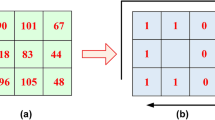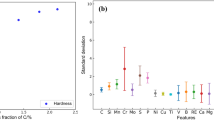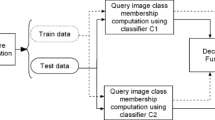Abstract
In recent times, machine learning-based methods have gained popularity in various materials science applications including microstructure image classification. This paper explores the use of classifier combination approaches for classifying the microstructure images with an improved accuracy. Classifier combination methods have been recognized as a state-of-the-art approach to enhance the performance of many challenging image classification tasks. Ensemble methods are used to increase the predictive performance of a learning system by combining the predictive performances of several base learners. In our proposed model, the features of three-class microstructural images are extracted using the rotational local tetra pattern feature descriptor. These features are separately fed to three different classifiers, namely support vector machine, random forest, and K nearest neighbor. Then, a classifier combination approach based on the confidence scores provided by these classifiers using fuzzy measures and fuzzy integrals is applied for the image recognition purpose. Unlike other straightforward classical classifier combination methods, this method nonlinearly aggregates the objective evidences in terms of a fuzzy membership function, with the subjective assessments of the relative importance of different classifiers. The proposed method has also been compared with many standard classifier combination approaches commonly found in the literature. The experimental results support the effectiveness of fuzzy combination to produce higher classification accuracy than that of the best base classifiers and some popular classifier combination methods.




Similar content being viewed by others
Data Availability
The dataset of the micrograph considered here is publicly available at http://uhcsdb.materials.cmu.edu
Code Availability
The source code for our method is our customized code written in MATLAB 2018b.
References
Clemens H, Mayer S, Scheu C (2017) Microstructure and properties of engineering materials. Neutrons Synchrotron Radiat Eng Mater Sci 66:1–20
Haralick RM, Shanmugam K, Dinstein H (1973) Textural features for image classification. IEEE Trans Syst Man Cybern 6:610–621. https://doi.org/10.1109/TSMC.1973.4309314
DeCost BL (2016) Microstructure representations: applied computer vision methods for microstructure characterization. PhD diss., Carnegie Mellon University
Gazder AA, Al-Harbi F, Spanke HT, Mitchell DRG, Pereloma EV (2014) A correlative approach to segmenting phases and ferrite morphologies in transformation-induced plasticity steel using electron back-scattering diffraction and energy dispersive X-ray spectroscopy. Ultramicroscopy 147:114–132
DeCost BL, Lei B, Francis T, Holm EA (2019) High throughput quantitative metallography for complex microstructures using deep learning: a case study in ultrahigh carbon steel. Microsc Microanal 25(1):21–29. https://doi.org/10.1017/S1431927618015635
Azimi SM, Britz D, Engstler M, Fritz M, Mücklich F (2018) Advanced steel microstructural classification by deep learning methods. Sci Rep 8(1):1–14
Chen D, Guo D, Liu S, Liu F (2020) Microstructure instance segmentation from aluminum alloy metallographic image using different loss functions. Symmetry 12(4):639. https://doi.org/10.3390/sym12040639
Ma B, Ban X, Huang H, Chen Y, Liu W, Zhi Y (2018) Deep learning-based image segmentation for al-la alloy microscopic images. Symmetry 10(4):107. https://doi.org/10.3390/sym10040107
Panda A, Naskar R, Pal S (2019) Deep learning approach for segmentation of plain carbon steel microstructure images. IET Image Process 13(9):1516–1524. https://doi.org/10.1049/iet-ipr.2019.0404
Gajalakshmi K, Palanivel S, Nalini NJ, Saravanan S (2018) Automatic classification of cast iron grades using support vector machine. Optik 157:724–732
Gola J, Webel J, Britz D, Guitar A, Staudt T, Winter M, Mücklich F (2019) Objective microstructure classification by support vector machine (SVM) using a combination of morphological parameters and textural features for low carbon steels. Comput Mater Sci 16:186–196. https://doi.org/10.1016/j.commatsci.2019.01.006
Gola J, Britz D, Staudt T, Winter M, Schneider AS, Ludovici M, Mücklich F (2018) Advanced microstructure classification by data mining methods. Comput Mater Sci 148:324–335. https://doi.org/10.1016/j.commatsci.2018.03.004
DeCost BL, Holm EA (2015) A computer vision approach for automated analysis and classification of microstructural image data. Comput Mater Sci 110:126–133. https://doi.org/10.1016/j.commatsci.2015.08.011
Arivazhagan S, Tracia JJ, Selvakumar N (2019) Classification of steel microstructures using modified alternate local ternary pattern. Mater Res Express 6(9). https://doi.org/10.1088/2053-1591/ab2d83
Chowdhury A, Kautz E, Yener B, Lewis D (2016) Image driven machine learning methods for microstructure recognition. Comput Mater Sci 123:176–187. https://doi.org/10.1016/j.commatsci.2016.05.034
DeCost BL, Francis T, Holm EA (2017) Exploring the microstructure manifold: image texture representations applied to ultrahigh carbon steel microstructures. Acta Mater 133:30–40. https://doi.org/10.1016/j.actamat.2017.05.014
Ling J, Hutchinson M, Antono E, DeCost B, Holm EA, Meredig B (2017) Building data-driven models with microstructural images: generalization and interpretability. Mater Discov 10:19–28. https://doi.org/10.1016/j.md.2018.03.002
Kitahara AR, Holm EA (2018) Microstructure cluster analysis with transfer learning and unsupervised learning. Integr Mater Manuf Innov 7(3):148–156
Ren F, Li Y, Hu M (2018) Multi-classifier ensemble based on dynamic weights. Multimed Tools Appl 77(16):21083–21107. https://doi.org/10.1007/s11042-017-5480-5
Nock K, Gilmour E (2020) Fuzzy aggregation for multimodal remote sensing classification. In: 2020 IEEE international conference on fuzzy systems (FUZZ-IEEE). IEEE, pp 1–7. https://doi.org/10.1109/FUZZ48607.2020.9177691
Wang Z, Wang R, Gao J, Gao Z, Liang Y (2020) Fault recognition using an ensemble classifier based on Dempster–Shafer theory. Pattern Recognit. https://doi.org/10.1016/j.patcog.2019.107079
Mukhopadhyay A, Singh PK, Sarkar R, Nasipuri M (2018) A study of different classifier combination approaches for handwritten Indic Script Recognition. J Imaging. https://doi.org/10.3390/jimaging4020039
Keller JM, Gader P, Tahani H, Chiang J-H, Mohamed M (1994) Advances in fuzzy integration for pattern recognition. Fuzzy Sets Syst 65(2):273–283
Cho S-B, Kim JH (1995) Combining multiple neural networks by fuzzy integral for robust classification. IEEE Trans Syst Man Cybern 25(2):380–384. https://doi.org/10.1109/21.364825
Banerjee A, Singh PK, Sarkar R (2020) Fuzzy integral based CNN classifier fusion for 3D skeleton action recognition. IEEE Trans Circuits Syst Video Technol. https://doi.org/10.1109/TCSVT.2020.3019293
Emadi M, Rahgozar M (2020) Twitter sentiment analysis using fuzzy integral classifier fusion. J Inf Sci 46(2):226–242. https://doi.org/10.1177/0165551519828627
Sarkar SS, Sheikh KH, Mahanty A, Mali K, Ghosh A, Sarkar R (2021) A harmony search-based wrapper-filter feature selection approach for microstructural image classification. Integr Mater Manuf Innov 66:1–19
Feng H, X Li, T Fan, Y Chen (2006) Some characteristics of fuzzy integrals as a multiple classifiers fusion method. In: Advances in machine learning and cybernetics. Springer, Berlin, pp 1014–1024
Ojala T, Pietikäinen M, Harwood D (1996) A comparative study of texture measures with classification based on featured distributions. Pattern Recognit 29(1):51–59. https://doi.org/10.1016/0031-3203(95)00067-4
Rybintsev A (2017) Age estimation from a face image in a selected gender-race group based on ranked local binary patterns. Complex Intell Syst 3(2):93–104. https://doi.org/10.1007/s40747-017-0035-y
Ruichek Y (2019) Attractive-and-repulsive center-symmetric local binary patterns for texture classification. Eng Appl Artif Intell 78:158–172. https://doi.org/10.1016/j.engappai.2018.11.011
Ojala T, Pietikainen M, Maenpaa T (2002) Multiresolution gray-scale and rotation invariant texture classification with local binary patterns. IEEE Trans Pattern Anal Mach Intell 24(7):971–987. https://doi.org/10.1109/TPAMI.2002.1017623
Murala S, Maheshwari RP, Balasubramanian R (2012) Local tetra patterns: a new feature descriptor for content-based image retrieval. IEEE Trans Image Process 21(5):2874–2886. https://doi.org/10.1109/TIP.2012.2188809
Tan X, Tiggs B (2010) Enhanced local texture feature sets for face recognition under difficult lighting conditions. IEEE Trans Image Process 19(6):1635–1650. https://doi.org/10.1109/TIP.2010.2042645
Zhang B et al (2009) Local derivative pattern versus local binary pattern: face recognition with high-order local pattern descriptor. IEEE Trans Image Process 19(2):533–544. https://doi.org/10.1109/TIP.2009.2035882
Xu L, Krzyzak A, Suen CY (1992) Methods of combining multiple classifiers and their applications to handwriting recognition. IEEE Trans Syst Man Cybernet 22(3):418–435
Sugeno M (1993) Fuzzy measures and fuzzy integrals—a survey. In: Readings in fuzzy sets for intelligent system. Morgan Kaufmann, pp 251–257. https://doi.org/10.1016/B978-1-4832-1450-4.50027-4
Murofushi T, Sugeno M (1989) An interpretation of fuzzy measures and the Choquet integral as an integral with respect to a fuzzy measure. Fuzzy Sets Syst 29(2):201–227
Jain AK, Duin RPW, Mao J (2000) Statistical pattern recognition: a review. IEEE Trans Pattern Anal Mach Intell 22(1):4–37. https://doi.org/10.1109/34.824819
Pham TD (2002) Combination of multiple classifiers using adaptive fuzzy integral. In: Proceedings 2002 IEEE international conference on artificial intelligence systems (ICAIS 2002). IEEE, pp 50–55. https://doi.org/10.1109/ICAIS.2002.1048051
Nguyen XT, Garg H (2019) Exponential similarity measures for pythagorean fuzzy sets and their applications to pattern recognition and decision-making process. Complex Intell Syst 5(2):217–228. https://doi.org/10.1007/s40747-019-0105-4
Abdullah L, Goh P (2019) Decision making method based on pythagorean fuzzy sets and its application to solid waste management. Complex Intell Syst 5(2):185–198
DeCost BL, Hecht MD, Francis T, Webler BA, Picard YN, Holm EA (2017) UHCSDB: ultrahigh carbon steel micrograph database. Integr Mater Manuf Innov 6(2):197–205. https://doi.org/10.1007/s40192-017-0097-0
Hoque Na M, Singh DKB (2018) EFS-MI: an ensemble feature selection method for classification. Complex Intell Syst 4(2):105–118. https://doi.org/10.1007/s40747-017-0035-y
Van Erp M, Vuurpijl L, Schomaker L (2002) An overview and comparison of voting methods for pattern recognition. In: Proceedings eighth international workshop on frontiers in handwriting recognition. IEEE, pp 195–200. https://doi.org/10.1109/IWFHR.2002.1030908.40747-017-0035-y
Funding
The authors declare that no funding support from any organization or agency.
Author information
Authors and Affiliations
Corresponding author
Ethics declarations
Conflict of interest
On behalf of all authors, the corresponding author states that there is no conflict of interest.
Additional information
Publisher's Note
Springer Nature remains neutral with regard to jurisdictional claims in published maps and institutional affiliations.
Rights and permissions
About this article
Cite this article
Sarkar, S.S., Ansari, M.S., Mahanty, A. et al. Microstructure Image Classification: A Classifier Combination Approach Using Fuzzy Integral Measure. Integr Mater Manuf Innov 10, 286–298 (2021). https://doi.org/10.1007/s40192-021-00210-x
Received:
Accepted:
Published:
Issue Date:
DOI: https://doi.org/10.1007/s40192-021-00210-x




